Liquidity in the secondary corporate bond market deepened last year and trading momentum has continued in 2017, according to electronic trading platform operator MarketAxess.
Over the past 12 months, the industry’s Trade Reporting and Compliance Engine showed high-grade corporate bond volume jumped 14% year-over-year. The increase was driven by factors such as uncertainty regarding the new US administration, Brexit preparations, and expected rate hikes, according to David Krein, head of research at MarketAxess.
To be sure, the deepening of liquidity applies to the market in broad sense, but liquidity sourcing outside of the most actively traded issues remains a significant challenge for market participants.
The increase in trading volume is up substantially compared to the typical 2 to 4% growth rates leading up to 2016. None of last year’s drivers have disappeared and companies are continuing to take advantage of the low rates by issuing into it, Krein noted.
Krein attributed much of the increase in liquidity to the record levels of new issuance that took place last year.

David Krein, MarketAxess
“In 2016 the new issuance market continued its record run of seven years of consecutive growth, with more than $1.5 trillion in new issuance volume,” Krein said. “The first two weeks of 2017 have already been identified as the most active first two weeks of any year.”
The corporate bond market’s increased trading activity on the back of modestly higher volatility are good signs for healthier and more liquid markets, he said. “Going into the election, essentially going into November 2016, the bid-ask spreads and certainly in high grades were the lowest they had been since we started recording in 2008.”
Also contributing to the greater liquidity has been the changing nature of trades that dealers are bringing to the market.
As dealers shy away from shy away from principal risk-taking in favor cheaper-to-transact agency trades, those trades also are narrowing the bid-ask spreads, he said citing daily crossable activity, or the share of the market that is potentially agency trades or non-principal trades.
High grade trades reached highs in daily crossable activity last year, jumping out of their regular range of 40 to 45%.
“In 2016, we estimate the share of Trace that was potentially transacted on an agency basis was 50 to 55%, which is at the high end of its historical range,” said Krein.
Dealers also have increased overall liquidity by expanding the range of Cusips that they are willing to trade. Krein noted that Trace data shows dealers are trading 15,000, and sometimes more than 16,000, Cusips per month, up from about 10,000 in previous months.
<





